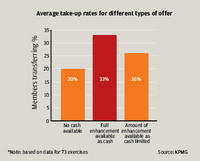With research finding 50% of schemes are considering an enhanced transfer value exercise to reduce their longevity risk, Ian Smith analyses five key elements of the process
Pension schemes have been urged to improve the quality of their data and communication to increase ETV take-up. Providers have also called them to consider limiting the amount of cash on offer to reduce the risk of a future backlash from ex-members.
Some 3,500 defined benefit (DB) schemes are considering ETV exercises for more than 2.5m deferred members, according to a KPMG survey. On the 30% average take-up it recorded from 83 completed exercises, this could reduce DB scheme liabilities by £100bn.
A scheme stands to gain from an ETV process by getting rid of some of its long-term liabilities, in terms of the longevity risk of these deferred members. It also loses some of the administrative burden of keeping them on board.
The sponsor benefits in the same way by reducing its pension liabilities, especially younger members who pose the longest-term risk to its funding. In return, the additional funding the sponsor provides to the scheme for the exercise improves the security of the rest of the members' pensions.
Running an effective ETV exercise
An ETV is any value offered to a deferred member to transfer their pension out of the scheme, which is above the statutory cash equivalent transfer value. The difference, known as the enhancement, can be paid fully or partly in cash.
There are five key steps to a successful exercise, according to consultants:
Providing the right offer to the right people. Often older members are excluded as they are thought less likely to transfer. Cash is a successful incentive but remains controversial, and more schemes are limiting the amount offered to reduce the risk of litigation.
Appointing the best independent financial adviser (IFA). Schemes often beauty-parade IFAs and opt for those with enough resources, a good reputation in this area and no past problems with regulators.
Data accuracy. Correct contact details are crucial for these exercises, which initially contact deferred members by post. Consultants recommend schemes verify their data to improve take-up.
Communication. Schemes are making use of DVDs, manned helplines and registration websites to explain this complex offer.
Project management. Ensuring the lines of communication with the adviser and helplines are kept open has a major impact on engagement, according to providers.
Duncan Howorth, chief executive at JLT Benefit Solutions, said it was important to make the information look different to usual communication, to convince members to read as much as possible.
He said: "Spend a bit of time and effort on the communication style. Bring out the features of the offer in the communication design."
The KPMG report found that while cash had a limited impact on member engagement with the transfer offer, it had a substantial impact on its take-up.
 Where no cash was available, the average take-up was 20%. Where the full enhancement was available as cash, the average was 33%.
Where no cash was available, the average take-up was 20%. Where the full enhancement was available as cash, the average was 33%.
Mike Smedley, a partner at KPMG, said: “It does suggest there are some members at least who find the cash more attractive than the same amount taken in pension. Given human nature, that is not particularly surprising.”
Where the amount of cash was limited, the average take-up was 26%. The survey reported anecdotal evidence that limiting the amount of cash available was on the rise among schemes.
Lesley Browning, a partner at Norton Rose, said this could be a signal to schemes to lobby employers to offer "bigger uplifts to the transfer basis" rather than a cash incentive.
Some schemes will not offer above a certain proportion or set amount of the enhancement as cash. Hybrid offers allow members to take part of the enhancement as cash, and leave part as a pension entitlement, to ensure members are not making a decision for the wrong reason.
“But it is also just managing their risk," said Smedley. "Companies don’t want people making the wrong decisions and coming back in 20 years time, saying you’ve mis-sold me a transfer.”
Clever maths
Chris Brown, a consultant at LEBC, said ETVs should be based on other factors such as a member's age, health and attitude to investment risk, rather than a one-level approach based on their benefit's critical yield.
A heavy drinker or smoker would be more attractive a proposition in the insurance market, due to their lower life expectancy, meaning the value offered to the member can be higher.
As the ETV market matures, parallel exchanges of risk for cash have grown up, including the pension increase exchange (PIE), where members exchange future pension increases for a higher flat-rate pension and sometimes a lump sum on top.
Such exercises allow schemes to reduce their costs in an environment where people are living longer and interest rates remain low. PIEs also lack the regulatory guidance of the ETV, leading some to take the view they can be offered without financial advice. But this is a risky game.
"If no advice was given in past exercises," said Browning, "members may be in a position to claim that their decision was not made on an informed consent basis."






















